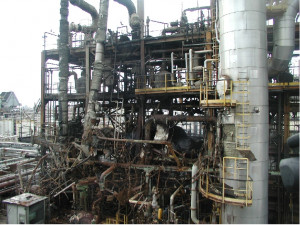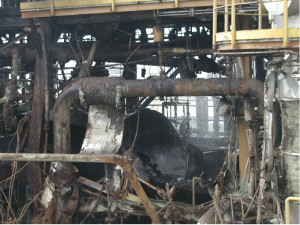At a chemical plant, a tank containing a mix of toluene-2,6-diisocyanate (TDI) / tars with a high boiling point increased in pressure and exploded around 7:40 pm. The cloud ignited 5 min later; afterwards, the fire was fed by 20 tonnes of oil and 1 tonne of toluene flowing from the burst pipes. An identical tank burst 40 min later due to a domino effect, causing a 2nd explosion whose blast extinguished the main fire.
In-house first responders and some 60 external fire-fighters were mobilised. The external emergency plan was lifted at 9:30 pm, and the internal plan at 10:45. Projected by the blast and sprayed by viscous fallout, 4 subcontracted workers received medical treatment and would be off the job between 3 and 53 days. External property damage was assessed at €2.8 million; internal damage resulting from pressure waves and flying metal fragments was extensive and affected: supporting frames, pipes, electrical connections, and installation utility lines. Some 15 tonnes of TDI/tar mix were released. The authorities conducted pollution measurements in the industrial park sewer system, revealing TDI concentrations of 5,280 mg/l. A temporary, yet intense, pollution of the water treatment lagoon was observed over more than 1 km. The atmospheric measurements recorded indicated a major presence of Nox / carbon, along with traces of hydrocarbons (toluene, ethylbenzene).
Following the maintenance shutdown of the reactor stirrer upstream of the damaged tank 48 hours prior, temperature rose from 150° to 230°C in the TDI/tar tanks. This temperature, coupled with extensive residence time (13 hr) in the tank, prompted the initiation of TDI exothermic dimerisation, with CO2 production as the source of this pressure build-up. A foam plug formed in the connecting pipe at the purge manifold prevented the tank’s safety disc from bursting. Inspection authorities also found no evidence of written procedures relative to a degraded mode of operations (such as the presence of high temperature). Moreover, none of the associated risks or tank pressure measurements, pressure increases in the TDI/tar tanks or eventual exothermic reactions had ever been specifically identified during the process risk assessment. The tanks were designed for a max. temperature of 95°C, while the measurement scale and calibrated instrumentation were set to tolerate temperatures of less than 120°C; moreover, temperature indicators were broken and tank pressure measurements were either missing or unusable. Prior to resuming plant activity, the operator performed a detailed safety evaluation of the entire site and undertook the technical/organisational modifications necessary to achieve and then maintain a high level of safety.
Download the detailed report in .pdf format (739 Kb)






